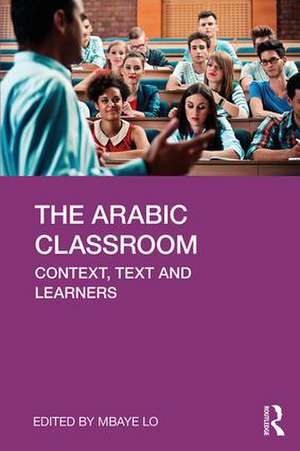The Arabic Classroom: Context, Text and Learners
Editat de Mbaye Loen Limba Engleză Paperback – 18 apr 2019
The book also provides a regional perspective through global case studies and encourages Arabic experts to search for better models of instruction and best practices beyond the American experience.
| Toate formatele și edițiile | Preț | Express |
|---|---|---|
| Paperback (1) | 390.03 lei 6-8 săpt. | |
| Taylor & Francis – 18 apr 2019 | 390.03 lei 6-8 săpt. | |
| Hardback (1) | 1005.01 lei 6-8 săpt. | |
| Taylor & Francis – 24 apr 2019 | 1005.01 lei 6-8 săpt. |
Preț: 390.03 lei
Nou
Puncte Express: 585
Preț estimativ în valută:
74.64€ • 77.64$ • 61.62£
74.64€ • 77.64$ • 61.62£
Carte tipărită la comandă
Livrare economică 14-28 aprilie
Preluare comenzi: 021 569.72.76
Specificații
ISBN-13: 9781138350793
ISBN-10: 1138350796
Pagini: 310
Ilustrații: 35 Line drawings, black and white; 5 Halftones, black and white; 22 Tables, black and white
Dimensiuni: 156 x 234 x 17 mm
Greutate: 0.47 kg
Ediția:1
Editura: Taylor & Francis
Colecția Routledge
Locul publicării:Oxford, United Kingdom
ISBN-10: 1138350796
Pagini: 310
Ilustrații: 35 Line drawings, black and white; 5 Halftones, black and white; 22 Tables, black and white
Dimensiuni: 156 x 234 x 17 mm
Greutate: 0.47 kg
Ediția:1
Editura: Taylor & Francis
Colecția Routledge
Locul publicării:Oxford, United Kingdom
Public țintă
Academic and Professional Practice & DevelopmentCuprins
Introduction. Part I: American Contexts of Teaching and Learning Arabic. Chapter 1: Taking the Arabic Classroom Beyond the American Experience: Navigating Context, Text and Students, Mbaye Bashir Lo. Chapter 2: A Survey of Arabic Syllabi at US Institutions: Pedagogical Implications, Hanada Al-Masri. Chapter 3: Arabic and the Problem of Learning: Experiences in Teaching Arabic at Two Historically Black Colleges and Universities, Aman Nadhiri and Maurice Hines. Chapter 4: On Arabic: Reflections from Edinburgh University to Duke University, Miriam Cooke. Part II: Texts and Textbooks in Teaching and Learning Arabic. Chapter 5: Evaluating Alif Baa Textbook: A Pedagogical Perspective, Badr Abdelfattah Badr. Chapter 6: Technology and Culture in the Arabic Classroom, Manar Darwish. Chapter 7: Principles of Teaching Arabic as a Foreign Language: A European Economical Point of View, Van Mol Mark. Part III: Methods and Methodology in Teaching and Learning Arabic. Chapter 8: Personalizing Proficiency: a Student-Centered Proficiency-Oriented Curriculum, David DiMeo. Chapter 9: The Arabyola Portal - Integrating Trusted Arabic e-Resources into Curriculum, Inas Hassan. Chapter 10: Teaching Grammar Orally through Colloquial Arabic –report of an Experiment, Rachael Harris. Chapter 11: Teaching Literature to Advanced Learners of Arabic: Methods and Tools, Rachel Friedman. Part IV: Students and Learners of Arabic. Chapter 12: Unleashing the Power of the Learner, Mahdi Alosh. Chapter 13: Toward a New Approach to Teaching Arabic Grammar: A Model for Arabic Learners, Mounira Gannouni, Qatar University. Chapter 14: 177 Connectives in the Writing of Native and Non-native Speakers of Arabic: Similarities, Differences and a Teaching Model, Nesrine Basheer. Chapter 15: The Arabic Plunge at Middlebury’s School in Jordan: Helping Students Swim after Diving into Jordanian Language and Culture, Kerstin Wilsch, Elsa Belmont Flores and Emily Goldman. Part V: The Global Contexts of Teaching and Learning Arabic. Chapter 16: Arabic Education In Chinese Universities: A Historical Perspective, LIN Fengmin and LIN Zhe. Chapter 17: The History of Arabic as a Second Language in Azerbaijan: The Textbooks of Professor Ali Asgar Mammadov, A Case of Study, By Aida Gasimova, Baku State University, Baku, Azerbaijan. Chapter 18: Arabic Education in the Southwest Nigeria: The Role of Private Arabic Schools (PASs), A.G.A.S. Oladosu. Chapter 19: How Arabic Fares in UK Schools, Vicky Gough and Tony Calderbank.
Notă biografică
Mbaye Lo is Associate Professor of the Practice of Asian and Middle Eastern Studies and International Comparative Studies at Duke University, USA. Dr Lo, a recipient of the Duke Alumni Distinguished Undergraduate Teaching Award, is the Arabic Program Coordinator and Director of Duke in the Arab World Academic Program.
Recenzii
"The Arabic Classroom should be essential reading for Arabic teachers, as it helps to raise the profession of Arabic teaching to a higher level. The Arabic Classroom’s well researched chapters can help Arabic teachers reflect on how they teach currently and think about how Arabic teaching pedagogy can move forward in the future." - Jonathan Featherstone, Senior Teaching Fellow of Arabic, University of Edinburgh, UK
"The Arabic Classroom is a welcome addition to the growing body of literature in the field of Arabic instruction. The wealth of innovative pedagogical techniques, program descriptions, case studies, and reflections by seasoned language professionals can only enrich the Arabic classroom experience and make it more rewarding and enjoyable for both teacher and learner. With its emphasis on the centrality of the role of Fuṣḥā, the book offers a reassurance to those concerned about its marginalization in Arabic-as-a-foreign-language programs." - Munther Younes, Reis Senior Lecturer in Arabic Language and Linguistics and Director of the Arabic Program, Cornell University, USA
"The Arabic Classroom is a welcome addition to the growing body of literature in the field of Arabic instruction. The wealth of innovative pedagogical techniques, program descriptions, case studies, and reflections by seasoned language professionals can only enrich the Arabic classroom experience and make it more rewarding and enjoyable for both teacher and learner. With its emphasis on the centrality of the role of Fuṣḥā, the book offers a reassurance to those concerned about its marginalization in Arabic-as-a-foreign-language programs." - Munther Younes, Reis Senior Lecturer in Arabic Language and Linguistics and Director of the Arabic Program, Cornell University, USA
Descriere
The Arabic Classroom is a multi-contributor work for trainee and in-service teachers of Arabic as a foreign language.
